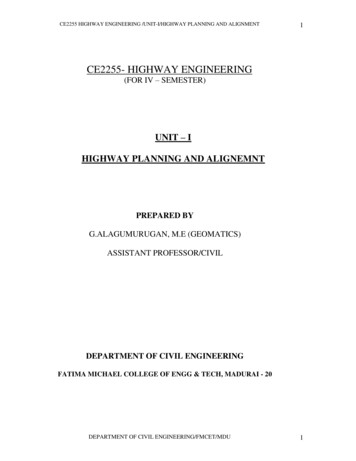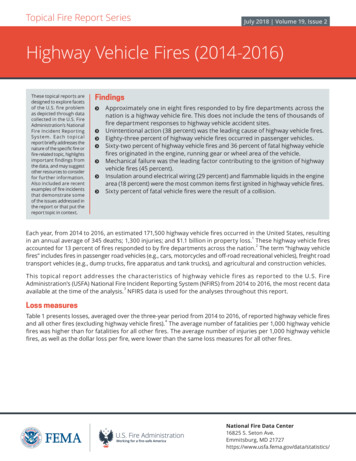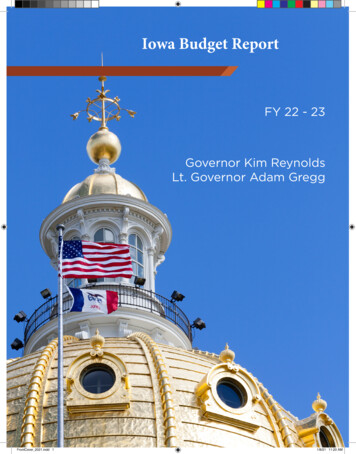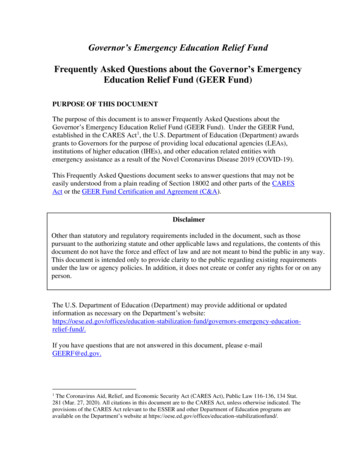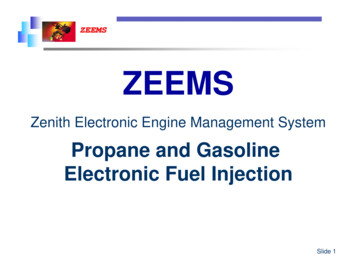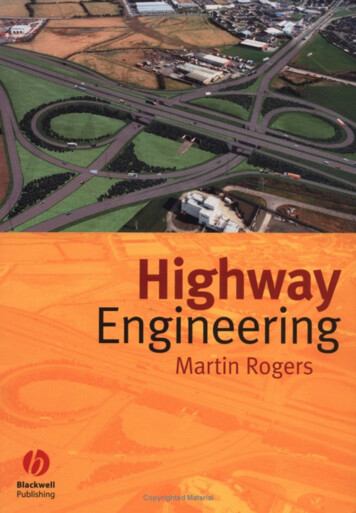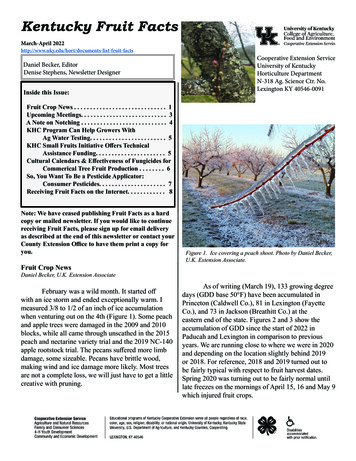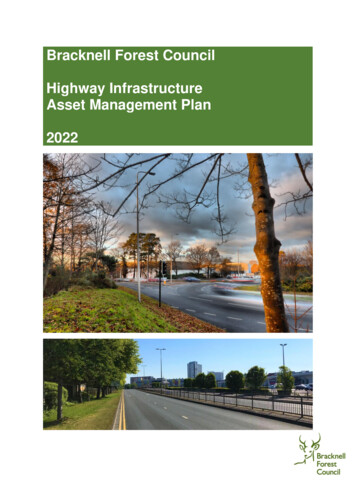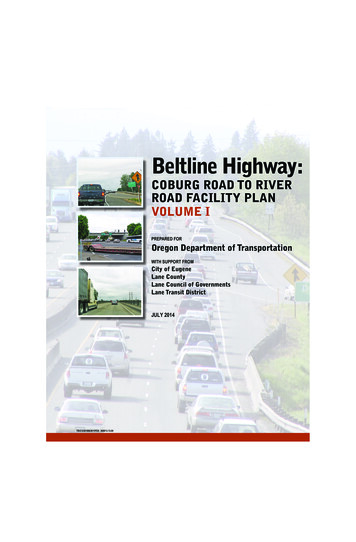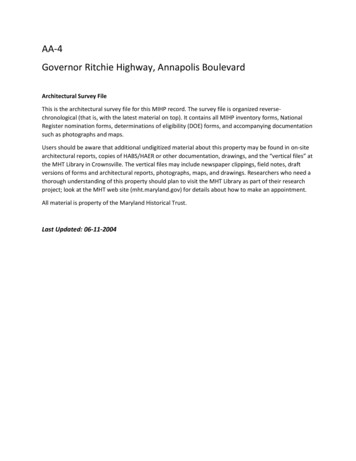
Transcription
AA-4Governor Ritchie Highway, Annapolis BoulevardArchitectural Survey FileThis is the architectural survey file for this MIHP record. The survey file is organized reversechronological (that is, with the latest material on top). It contains all MIHP inventory forms, NationalRegister nomination forms, determinations of eligibility (DOE) forms, and accompanying documentationsuch as photographs and maps.Users should be aware that additional undigitized material about this property may be found in on-sitearchitectural reports, copies of HABS/HAER or other documentation, drawings, and the “vertical files” atthe MHT Library in Crownsville. The vertical files may include newspaper clippings, field notes, draftversions of forms and architectural reports, photographs, maps, and drawings. Researchers who need athorough understanding of this property should plan to visit the MHT Library as part of their researchproject; look at the MHT web site (mht.maryland.gov) for details about how to make an appointment.All material is property of the Maryland Historical Trust.Last Updated: 06-11-2004
AA-4Governor Ritchie Highway (Rt. 2)Annapolis to BaltimoreUSGS Quads: Annapolis, Gibson Island,Round Bay & Curtis BaySiteBuilt 1934-1939Ritchie Highway is significant as Maryland's first dual highway and the first state road built withthe mandate to preserve natural and scenic beauty. Originally named Annapolis Boulevard itwas posthumously renamed in honor of Maryland Governor Albert C. Ritchie, who greatlyadvanced Maryland's road system to one of the best in the nation.Built as a direct and scenic route between Annapolis and Baltimore, Ritchie Highway wasconstructed at a cost of 2.25 million dollars. Most of the funding was provided by the federalPublic Works Administration. Despite appeals to keep the highway free from unsightly andtransportation-hindering development, Ritchie Highway grew into an important commercialcorridor and became the locus of some of the state's commercial first, including the first enclosedshopping mall east of the Mississippi River.
Survey No. AA-4Maryland Historical TrustState Historic Sites Inventory Form1. NameMagi No.DOEyesno(indicate preferred name)historicAnnapolis Boulevardand/or commonGovernor Ritchie Highway (Rt. 2)2. Locationstreet & number44.1 miles between Annapolis (at Rt. 450) and Baltimorecity, townvariousstateMarylandvicinity ofnot for publicationcongressional districtcountyAnne Arundel3. x siteobjectOwnershipx publicprivatebothPublic Acquisitionin processbeing considerednot applicable4. Owner of PropertyStatusoccupiedunoccupiedwork in progressAccessibleyes: restrictedx yes: unrestrictednoPresent vernmentindustrialmilitarymuseumparkprivate residencereligiousscientificx transportationother:(give names and mailing addresses of all owners)nameMaryland Department of Transportationstreet & number707 North Calvert Streetcity, townBalitmoretelephone no.:state and zip code:Maryland1-800-323-6742212035. Location of Legal Descriptioncourthouse, registry of deeds, etc.Anne Arundel County Courthouseliberstreet & numberFranklin Streetfoliocity, townAnnapolisstatevariousMaryland6. Representation in Existing Historical Surveystitlefederalstatedepository for survey recordscity, townstatecountylocal
7. uinsunexposedSurvey No.Check onex unalteredalteredAA-4Check onexoriginal sitemoveddate of move---Prepare both a summary paragraph and a general description of the resource and its various elements as it exists today.Ritchie Highway (Rt. 2) is a 44.1 mile-long, state-maintained, asphalt-paved, dual highway. It is bounded onthe south by the Severn River, where it becomes Rt. 450, and on the north by Baltimore City's corporate limits, atwhich time it changes to Hanover Street.Constructed as a direct but scenic route between Annapolis and Baltimore, Ritchie Highway runs in a straightnorth-westerly path from Annapolis to Glen Burnie. Here, at the intersection with Crain Highway (Rt. 3), it turnseast, then gradually corrects and travels north until its termination at the Baltimore City line.Ritchie Highway was built with two 20' lanes traveling in either direction, separated by a 6' grass and/or tree-linedmedian. As opposed to the then standard practice of clear cutting the entire right of way, existing trees wereretained in the median and along the road's side so that motorists could drive in an enjoyable park-like setting.Engineers also designed Ritchie Highway to respect the route's natural topography. As a result, the corridorfeatures a long series of low, gently-sloping hills and valleys.Intense commercial development has robbed large sections of Ritchie Highway of its defining "scenic" features. This isespecially true in north Severna Park, Pasadena and Glen Burnie, where medians have routinely been raised and paved, orconverted into center turn lanes. Integrity is further lost through lane widening, the paving of once soft shoulders, andco.overting shoulders into exit lanes and merge areas. More than fifty traffic lights regulate vehicles along the cooridor.Jrding to the Maryland Department of Transportation, approximately 48,975 automobiles travel Ritchie Highwayeach day. Congestion, combined with strip mall development leave large portions of this route unrecognizable as ascenic parkway. Information provided by the Maryland Department of Transportation reports that at last countRichie Highway was home to 54 shopping centers and 66 fast food franchises.In contrast, the extreme southern part of Ritchie Highway-- the segment from Arnold to the Severn River-- remains intactand fully able to communicate the characteristics for which it is significant. The scenic and park-like qualities of this segment are further enhanced by the presence of the Governor Ritchie Memorial and Scenic Overlook (AA-3), and the recentlyconstructed World War II memorial. Located at the highway's southern end, in an expanded section of median,these memorials stand a top a low hill overlooking the Severn River and the City of Annapolis. These smallmemorial parks affirm that Ritchie Highway, at least in part, remains a place of beauty and enjoyment, aswell as an important and historic transportation corridor.
8. SignificancePeriodprehistoric-- 1400-14991500-15991600-16991700-17991800-1899x 1900Specific datesCheck:Survey No.Areas of Significance----Check and justify belowarcheology-prehistoriccommunity ation/settlementx icable Criteria:and/orApplicable Exception:Level of Significance:Builder/Architectxx landscape l/humanitariantheaterx transportation--other (specify)Maryland Roads Commission Chief Engineer WillarABcDABcDnational-x- stateEFGlocalPrepare both a summary paragraph of significance and a general statement of history and support.Constructed from 1934-1939, Ritchie Highway is significant as Maryland's first dual highway, and the firststate road built with the mandate to preserve natural and scenic beauty. Originally known as AnnapolisBoulevard, the highway was posthumously renamed in honor of former Governor Albert C. Ritchie who between1919 and 1934 served four terms as Maryland's chief executive. Ritchie Highway was constructed at a cost of2.25 million dollars, principally with federal funds provided by the Public Works Administration under theIndustrial Recovery Act. This undertaking was part of Ritchie's ambitious ten year/3,000 mile road buildingprogram designed to stimulate trade (1 ) .1ie Highway provided a direct route between Baltimore and Annapolis and an alternative to the meandering Baltimore andAnnapolis Boulevard (Rt. 648) which roughly followed the late 18th century route from the Severn River to Baltimore (2).Upon completion, Ritchie Highway was celebrated for halving the drive time between the two cities.Construction began in 1934 and featured two 20' roadways separated by a 6' median. Before 1934 it was typicalhighway practice to clear cut the right of way of trees. After much debate, it was decided that whenever possible,mature trees would be retained along the roadside and in the median to provide a pleasurable driving experience in apark-like setting. Ritchie Highway and Pulaski Highway (then in planning) were conceived as Maryland's show roads.According to State Roads Commission chief engineer Willar, the intention was to "have the road blend with thelandscape rather than have it sticking out like a sore thumb" and make changes in the landscape "resemblingplastic surgery rather than butchery" (3).Earnest appeals were made to commercial interests to keep Ritchie Highway free from bill boards and development.At first these efforts were successfully, but eventually the business potential proved irresistible and the 44.1 mileparkway developed into a major commercial corridor. Ritchie Highway spawned some of the state's commercialfirsts, including the first drive-in movie theater, and Harundale Mall, the first enclosed shopping mall east of theMississippi River (4).In addition, Ritchie Highway serves as an important antecedent to the 1954 Baltimore-Washington Parkway (AA-5).Listed on the National Register of Historic Places, the Baltimore-Washington Parkway is Maryland's fullest expression ofthe philosophical principals set forth in the construction of Ritchie Highway.Only portions of Ritchie Highway retain enough integrity to be considered a scenic byway. The most intact section isted at the southern end, between Arnold and the Severn River. North Ritchie Highway, especially near Severna Park,l-asadena, and Glen Burnie retains the least integrity.
9.Major Bibliographical ReferencesSurvey No AA-4(1) Bradford, James. Anne Arundel County· 1649-1977(2) Tassy, Elaine. Arundel's "main drag": a trip through rural, urban history. Baltimore Sun newspaper,August 10, 1997, Baltimore, Maryland.('.''--1.(elly, Jacques. Anne Arundel County· A Pictorial History, The Donning Company, Norfolk, Virginia.(·., Jid10. Geographical DataAcreage of nominated property44.1 miles----------Quad rang Ie nameAnnapolis, Round Bay, Gibson Island, Curtis BayUTM ReferencesDo NOT complete UTM referencesALJ JZoneI IIEastingIIIIIIIIIIIBLJ JZoneNorthingCLJ jDLJ jELJ jFLJ JGLJ jHLJ jQuadrangle scale 1: 24,000--------I I IEastingIINorthingVerbal boundary description and justificationBegininning at Rt. 2 at the interesection with Rt. 450 and terminating at the Baltimore City corporate limits.List all states and counties for properties overlapping state or county boundariesstatecodecountycodecodecountycode11. Form Prepared byname/titleSherri MarshorganizationAnne Arundel County Historic Sites Surveystreet & numberDepartment of Planning, 2664 Riva Roadcity or townAnnapolisdate September, 1998stateMDThe Maryland Historic Sites Inventory was officially created byan Act of the Maryland Legislature to be found in the AnnotatedCode of Maryland, Article 41, Section 181 KA, 1974 supplement.The survey and inventory are being prepared for information andrecord purposes only and do not constitute any infringement ofindividual property rights.return to:Maryland Historical TrustDHCP/DHCD100 Community PlaceCrownsville, MD 21032-2023410-514-7600PS-2746
MARYLAND COMPREHENSIVE HISTORIC PRESERVATION PLAN DATAAnnapolis, Anne Arundel County, MarylandSurvey Number: AA-4Governor Ritchie HighwayGeographic Organization: Western ShoreChronological/Developmental Period(s): Modem Period ( 1930-present)Historic Period Theme(s): transportation, landscape architecture, economicResource Type:Category: siteHistoric Environment: rural and suburbanHistoric Function(s) and Use(s): highwayKnown Design Source: Maryland State Roads Commission engineering staff
Continuation Sheet (AA-4) Governor Ritchie HighwayPhotos taken from Anne Arundel CountY: A Pictorial Riston, b Jacques Kelly, publishedby The Donning Company, Norfolk, VA (1989).Aucomobile high11·ays encoura!!edconstruct1on of re. caurani. o. Here. in19-10. is the Sen?rn Inn. sc rhe northern end of the Se\·ern Ri\·er Bridge stche junction of Ritchie Hi"ghll'BY andthe old Annapo/i,,; Road. News American photo, from the auchor collection.sOne of the first large commercialenterprises along Ritchie Highway wasGo1·ernor Ritchie Open Air Theatre,J\-fsy 12, 1939. News American photo.from the authors collectionWhen chis scares firsc drfre-ii: opened,there were open field:;. and orchardsaround a spot that would becomehea\·i/\" commercial/I- de\·eloped. Themo\·ie. theater c/o.-;ed in the 19 0: andit;. site became a housin§f uacc. Thephoto 11·11:; taken in the spring uf 19.W.News American photo, from rheauthor collection179
Continuation Sheet (AA-4) Governor Ritchie HighwayPhotos taken from Anne Arundel Count)': A Pictorial Historv. by Jacques Kelly, publishedbY. The Donning Company, Norfolk,VA (1989).T11·0 phmo. of the same scene sho11·thf changl!:- in chircy-one years thac in ·tense : uburban de1·efopment hrou!!ht.Here. in Js11usr1· 1935 traffic is li,;.hralong what wouid be named RitchieHighwa.1. l\ews American photoby .fa ·k Shipley. from the suchor'sC(l//ec11onIn January 1966, the same scene hadchanged considerably. The BaltimoreBe/rn·ay bas been construcced andtraffic has increased msm· times 01·er.Thf' old Ritchie Farmers ·Market. sincedemolished. scsnds st the right. TheBelt11·sy changed lfring patterns andthe face of the entire metropolitanarea. ews American phoco, from theauthor':- collectionWhen ic opened. Ritchit Hi!:h11·a1 · 11".'l"con:;idt red a mC1del ot If:- 1.1:pe. Thi,.::rrerdi faces Cedar Hill Cemecen· /JI\l)·lit .\ 1·em1e. \ fa rch 19, 1 1./ I. BernardTarleton ph(ltO, HalcinlClre Gs:- andEleccric C mpany Col/err iilll. rhe Pt lleJ\lu::eum. 811/iim re177
Mr,. H1 rl11 r1 U. O'C'1111c r s11ips a black;111rl ;:11/rl ri l /11111 ti 1r the o(ficinl 11pe11ill;: ,,ft ht Uc11N11c1r Albert C. RitchieH i:h1rny. April 2-:. 19./0.'ome momhsnfter t lit d1111l hi.r:h11·s1· had beenopenf'd to traffir Ezra B. Whitman.chairman of the .::itsre Roads Commissicm. ,.tm1d:. st :he ri;:ht .\'an· liomben:lmzud m·erhe.'ld and there 11·as a paradf' of Bu.1 and Girl Scours, World\I".,, l 1·C'teran and 1he ]\'acionalGwird 1\ews Arnerkan photo byS1·d11P1 S. :jussm311.In Sept mber 1939, the last section ofRitchie Hi;:hll'a I' 10 be completedsliced through the pine and deciduousforef'.ls of Anne Arundel Countv. Thephotc incorporates the three sinmeans of transporl81ion along theAnnapolis-Baltimore route. Al thelC'fr .m the tracks of the Baltimore &Annapolis Railroad. Paralleling themis the Baltimore and Annapolis Boule·1 ard. 11·11h Ritchie Highll'BJ' in the center. Jones Station Road is in the uppercenter. with Fishpall''s Amoco stationat 1he lower left. Photo frum theauthor's collec1ionrContinuation Sheet (AA-4) Governor Ritchie HighwayPhotos taken from Anne Arundel County: A Pictorial History. by Jacques Kelly, publishedh Thr Oonning Company. Norfolk, \'A (1980).
ro1 nBALTIMOREANNE ARUNDEL COUNTY, MD\j "' ": I"'.-.Source: ADC, Anne Arundel County, Maryland (1996)Scale: 1' 3 miles i)';J&:.I rIISUllll'llSUOFUITiiiiii'g o.Clllm:ffl 0.it.I7wm40RR AIR PARIC,AllAOISfISUIOII !.IP!"':! KentIslandKUIT IORT 'MAIOR p .,. . Ii'h )x.,,,
13CURTISBAYI30"'I,/I',,. '. - .--\ ·,.· ;.: . "o ( ,,,11-\ . .- Thoma Pl.·."·o··"311,o"''
II. "'I '·. f "('. ""'-. r.:::·.,,,.,. -/. Ot
--- 'fJ
A t\n\) C\j'Jc)\' .\o \.\-, M1. . -eOj 5 h l?. {' f\. \l1R hl f'v\ o. ,'(,Ne a. ·h v e '-AR Ne loV (1tV,ite\"-l "'k- ., f'"C)v""'
I "' a. \ .v.1 \ ( K.-\., .:? )A-N f\J a f oL -h-. l ""'·o ", ' !' "-0 ,\cl\oCbj Sh \ MaR5 t q45e.ve ie. N"' \w' ), v1( 1 N; \-/ ; IMk .r'l '3 o u-\- V,V\Je:J"" "e R"{ l"-"3o\ s 1-\- c?h. o cl. o :)
the mandate to preserve natural and scenic beauty. Originally named Annapolis Boulevard it . . 1ie Highway provided a direct route between Baltimore and Annapolis and an alternative to the meandering Baltimore and . Crownsville, MD 21032-2023 410-514-7600 MD PS-2746 . MARYLAND COMPREHENSIVE HISTORIC PRESERVATION PLAN DATA
